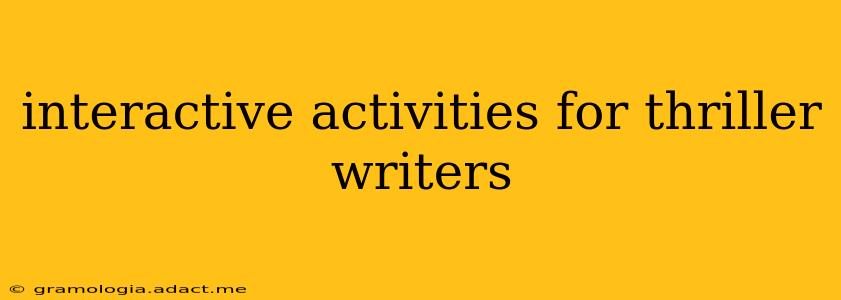Thriller writing demands more than just a captivating plot; it requires a deep understanding of suspense, character development, and pacing. To hone your skills and keep your creative juices flowing, interactive activities are invaluable. These exercises move beyond passive reading and writing, encouraging active engagement with the core elements of a successful thriller.
What Makes a Good Thriller? Interactive Brainstorming
Before diving into specific activities, let's lay the groundwork. Gather with fellow writers (or even brainstorm solo) and discuss the essential ingredients of a gripping thriller. Consider these questions:
- What are the most effective ways to create suspense? (e.g., ticking clocks, unreliable narrators, foreshadowing, red herrings)
- How do you build believable and compelling characters? (e.g., flaws, motivations, relationships)
- What are some innovative ways to structure a thriller plot? (e.g., multiple timelines, shifting perspectives, unreliable narrators)
- What makes a twist ending truly shocking and satisfying? (e.g., foreshadowing without giving it away, unexpected connections)
This brainstorming session will not only generate ideas for your own writing but also provide a shared understanding of thriller conventions to inform the following interactive activities.
Interactive Activity 1: The "What If?" Scenario Generator
This exercise focuses on generating plot ideas and exploring character motivations. Start with a simple premise:
Example: A seemingly ordinary librarian discovers a hidden message in a returned book.
Now, use the "What If?" approach to expand this premise:
- What if the message is a coded threat?
- What if the librarian has a secret past connected to the message?
- What if the book itself is a key to unlocking a larger conspiracy?
- What if multiple people are after the librarian?
Continue this process, adding layers of complexity and exploring different possible outcomes. This exercise helps you develop creative scenarios and think outside the box.
Interactive Activity 2: Character Creation Workshop – The "Reverse Interview"
This activity delves into character development. Choose a character archetype (e.g., the reluctant hero, the enigmatic villain) and conduct a "reverse interview." Instead of you interviewing the character, the character interviews you.
Imagine your character asking you questions about their motivations, past experiences, relationships, and fears. Answer from their perspective, using their voice and worldview. This deep dive allows you to uncover hidden layers of complexity and build a more believable and relatable character.
Interactive Activity 3: Pacing and Suspense – The "Scene-by-Scene" Breakdown
Pick a favorite thriller scene and dissect its structure. Analyze the pacing, the use of suspense techniques (e.g., cliffhangers, foreshadowing, red herrings), and the emotional impact on the reader. Discuss how the author creates tension and releases it at strategic points. This exercise helps you understand the mechanics of suspense and apply them to your own writing.
Interactive Activity 4: The "Twist Ending" Challenge
This activity is all about crafting surprising and satisfying conclusions. Start with a seemingly straightforward premise (e.g., a detective investigating a murder). Develop the plot to a point where you have a seemingly obvious resolution. Then, introduce a twist that completely changes the reader's perception of the events. The twist should be both shocking and believable, satisfying the reader's need for closure while leaving them with a lingering sense of wonder. Consider sharing your twist endings with fellow writers for feedback.
Interactive Activity 5: Collaborative Thriller Writing
This activity requires a team. Each writer contributes a section of the story, building upon the previous section. This encourages collaborative storytelling and allows you to explore different writing styles and perspectives. Set guidelines beforehand (e.g., word count per section, character limitations) to maintain coherence.
By actively participating in these interactive activities, thriller writers can significantly improve their skills, unleash their creativity, and craft more compelling and memorable stories. Remember, the key is to engage actively, experiment boldly, and have fun with the process!
